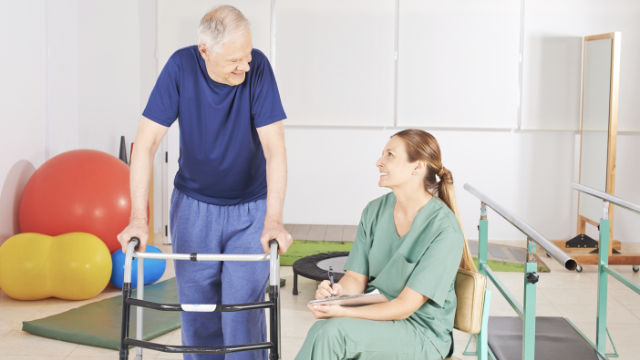
For individuals over the age of 75 or 80, thinking about falling can occupy a great deal of mental energy and lead to excessive fear of movement in the process. This is completely understandable, as falls are the leading cause of injury for older adults and the odds of suffering from a fall increase as one gets older. Approximately 40% of older adults living at home experience one fall per year, and this figure is even higher for adults living in nursing homes and assisted living facilities.
One of the most effective strategies to reduce this risk of falling is for older adults to use a walking aid like a cane or frontâwheeled walker at all times. These devices assist with upright balance and mobility, which are essential for avoiding a fall; however, some research has suggested that using a walking aid may also increase the risk for falling in some individuals. This may seem counterintuitive, but is likely because certain adults do not use the devices properly, usually from a lack adequate guidance.
Study highlights the potential dangers of assistive devices
With this in mind, a study was conducted to investigate the advantages and possible disadvantages of using canes and walkers. Researchers performed a search of two major medical databases for studies that evaluated the use of singleâtip canes and pickup walkers for their benefits related to falls/injuries or other physical demands. This search led to more than 1,000 studies being identified, and about 10% of these were included in the review.
Upon review, researchers determined that there was ample evidence to indicate that canes and walkers can improve balance and mobility in older adults and patients with certain clinical conditions. However, researchers also identified several studies showing that a large proportion of individuals do experience difficulty when handling assistive devices, and this improper usage increases their risk of falling. For example, the act of lifting a cane or walker can have a destabilizing effect by potentially disturbing the userâs center of mass, but this can be countered by making certain adjustments to their posture.
This highlights the need for proper guidance when an older adult is first given an assistive device to ensure that they are using it correctly and to reduce their risk for falling. Physical therapists are experts in the proper use of walking aids, and we strongly recommend that you see a physical therapist for specific instructions and to answer any questions you might have about their use. To give you a general overview of what this type of session will entail, the following tips cover some of the primary points that weâll focus on.
5 tips to ensure the proper use of an assistive device
- Use proper positioning when holding your cane
- The cane should always be held in the hand of the stronger leg
- This means if your right leg is stronger than your left leg, hold your cane in the right hand and advance it forward when the left leg steps forward
- When standing up straight, the top of your cane should reach to the crease in your wrist, and your elbow should be slightly bent when holding the cane
- The cane should always be held in the hand of the stronger leg
- Up with the good, down with the bad
- When going up stairs with a cane, step with the stronger leg first while holding onto the railing
- Once that foot is on the stair, step up with the weaker leg
- This allows the stronger leg to do most of the work to push the body up the stair while leaving minimal work for the weaker leg
- When coming down stairs, step with the weaker leg first while holding onto the railing
- Once that foot is on the stair, step down with the stronger leg
- Use proper positioning with your back straight
- When standing up straight, the top of your walker should reach to the crease in your wrist and your elbows should be slightly bent when you hold the handgrips of the walker
- Keep your back straight and don’t hunch over the walker
- Keep your body aligned with the walker when walking
- Be sure to keep the front of your body in line with the back two posts of the walker before moving the walker
- Advance the walker a few inches in front of you first, and make sure and make sure all tips and wheels are touching the ground before taking a step
- Step forward with your bad leg first, then step forward with your good leg, placing it in front of your lead foot
- Other
- Make sure the rubber tips on your walker’s legs are in good shape and replace them if they are worn out
- Take your time and never rush when using these devices
- If you donât feel comfortable using a cane with a single point, let someone know; a quad cane or walker may be more appropriate for you
While these tips should serve as good reminders, we canât emphasize enough the importance of seeing a physical therapist for handsâon guidance. Therefore, we encourage you to schedule an appointment with one of our therapists today to learn the proper way to use your assistive device.
